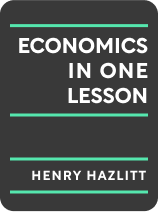

This article is an excerpt from the Shortform book guide to "Economics in One Lesson" by Henry Hazlitt. Shortform has the world's best summaries and analyses of books you should be reading.
Like this article? Sign up for a free trial here .
What are the key takeaways of Economics in One Lesson by Henry Hazlitt? What are the secondary consequences of the economic policies the government puts in place?
In this often-cited book Economics in One Lesson, Henry Hazlitt gives a clear, concise explanation of the secondary consequences of a range of economic policies. He posits that failure to consider the long-term, broad effects of policies leads the government to make decisions that sometimes exacerbate the problem they intend to solve.
Here is a brief overview of Economics in One Lesson: The Shortest and Surest Way to Understand Basic Economics by Henry Hazlitt.
Economics in One Lesson: The Shortest and Surest Way to Understand Basic Economics
Economics In One Lesson by Henry Hazlitt explains and illustrates the single most important lesson in economics: Every economic policy has secondary consequences that often do the opposite of the intended effect of the policy. Policies such as tariffs and minimum wage raises are enacted based on fallacies that overlook these consequences. At the root of these fallacies is a tendency to consider only how economic policies will affect specific groups of people in the short term, while neglecting the long-term effects on other industries and consumers. Failure to consider the long-term, broad effects of policies leads the government to impose policies that sometimes exacerbate the problem they intend to solve. In this summary, we’ll explore the consequences of economic policies and government interventions—including rent control, inflation, and tariffs—that result from short-term, narrowly focused fallacies.
Below is a quick summary of the key takeaways from Economics in One Lesson: The Shortest and Surest Way to Understand Basic Economics.
Tax-Funded Expenses Inhibit Private Industry Growth and National Wealth
Some of the most prevalent fallacies revolve around taxes. Some tax-funded projects are essential to keep the country running. But when the government uses taxes to fund projects and pay wages that are unnecessary, the consequences outweigh the benefits.
Public Works Projects Divert Money From Private Industry
Fallacy: Public works projects and other tax-funded projects create jobs and wealth.
Reality: Public works projects and other tax-funded projects divert resources and manpower that would have otherwise supported jobs in private industries.
While some public works projects create necessary structures like roads and bridges, the government launches others primarily to create jobs—but it fails to see the invisible costs. Government spending is paid through taxes, meaning that public works projects come at the cost of the goods and services that individuals would have bought with the money they paid in taxes. This means less money for the merchants providing those goods and services to put toward wages, and lower wages offset the jobs that are created on the public works project.
Furthermore, high taxes cause businesses to slow or stop expanding, avoid starting new companies, delay upgrades to production facilities, reduce job creation, and limit wage raises. Similarly, high taxes make people reluctant to spend or invest their money, which hurts private industry growth.
Government Payroll Reduces Purchasing Power
Fallacy: Government-paid jobs have no negative impact on private industry.
Reality: When government-paid jobs are no longer needed, continuing to fund them with taxes hurts national productivity and wealth.
Taxpayers fund the salaries of members of the military and civilian government workers, and their work is critical to the country’s well-being, but when their services are no longer essential, they become a drain on national productivity and collective wealth. Every tax dollar that goes to paying government workers is a dollar that taxpayers can’t pay to an industry that produces goods, which contributes to national wealth. Lawmakers should regularly evaluate the necessity of all jobs on government payroll and eliminate those that are not needed.
Maximizing Production Levels Increases National Wealth
Many policies use various schemes to save jobs, increase employment, or increase wages. However, the ultimate goal should be to increase production levels, because more output creates larger profits for businesses, enabling them to expand production, hire more workers, and/or raise wages.
Technology Doesn’t Kill Jobs
Fallacy: Labor-saving technology reduces jobs and, thus, collective wealth.
Reality: Labor-saving technology increases productivity and collective wealth, which often leads to an increase in employment.
For centuries, people have mistakenly blamed labor-saving machinery for eliminating jobs. However, any jobs that would be lost to more efficient equipment are offset by:
- The jobs of the people who make and repair the equipment
- Savings in labor costs, which the company could use to expand and create new jobs
- Increased profits due to greater efficiency, which means that company executives and employees have more money to spend on goods and services that support those merchants
- Lower prices for products due to greater efficiency, which allows customers to either buy more of those products or support other industries by buying their products and services
Overall, labor-saving machines raise production rates, economic well-being, and standard of living—and an increase in employment generally results from those effects.
Spreading the Work Decreases Productivity and Employment
Fallacy: Spread-the-work practices lead to higher employment.
Reality: Spread-the-work practices decrease productivity and employment levels.
The fallacy that efficiency kills jobs—and that inefficiency leads to higher employment—leads to labor union practices that spread the work among as many people and over as many hours as possible. These practices include:
- Subdivision of labor, which mandates that only members of a particular union perform tasks that are specific to that trade—even if the tasks are minor aspects of another worker’s job. For example, a plumber isn’t allowed to remove tiles herself in order to replace a pipe in the shower. Instead, she must call a tile-setter to remove and subsequently repair the tiles. Although two people get work for the day instead of one, dividing labor increases the cost of production, which takes money away from other industries (for example, the homeowner with the broken shower could have spent the tile setter’s wages on buying a sweater).
- Promoting shorter work weeks with overtime pay past 30 hours. This strategy aims to increase an employee’s pay through overtime, or to give employment to other workers who pick up existing employees’ cut hours. However, since this strategy doesn’t increase production—which is the only way to increase employment and wages—shorter work weeks either reduce employees’ pay, cause unemployment, or lead to higher prices for goods in order to recoup the increased labor costs.
Full Production—Not Full Employment—Increases National Wealth
Fallacy: Full employment is the goal for national wealth and a high standard of living.
Reality: Full production is the goal for national wealth and a high standard of living.
Many people mistakenly believe full employment is the surest way to increase Americans’ prosperity and the national wealth. However, unless production and profits increase in order to support larger payrolls, simply creating more jobs comes at the expense of other jobs, because the money to pay those new workers has to shift from somewhere else. In reality, the goal should be to achieve maximum production, which raises wealth by creating a need for additional workers and provides more goods and services for everyone.
Government Efforts to Help Industries Often Hurt the Economy Overall
When the government intervenes in private industry—even in an effort to help—it interferes with the natural equilibrium of supply and demand and creates unintended ripple effects.
Government Loans Support Inefficient Businesses
Fallacy: Government loans enable individuals and businesses to achieve prosperity that they otherwise couldn’t, which contributes to collective productivity and wealth.
Reality: Government loans divert resources away from the businesses and individuals who could create the most productivity and wealth, to businesses and individuals who would and should be weeded out by private industry standards.
Whereas private lenders have strict standards for selecting loan recipients, the government risks taxpayers’ money giving loans to people who fall short of private lenders’ standards. These borrowers are less likely to have the skills and experience to make enough profits to repay the loans. Additionally, businesses use the loans to buy capital (such as equipment and facilities), which is limited in supply. When the government gives a loan to an inefficient business, the capital it buys becomes unavailable to efficient businesses, which would have used it to be more productive and, thus, make greater contributions to employment and national wealth.
Tariffs Support Inefficient Industries
Fallacy: Tariffs (taxes on imported goods) help domestic industries compete in a global market, which prevents employees in those industries from losing their jobs.
Reality: Tariffs shift money, manpower, and productivity away from efficient industries in order to support inefficient industries.
Tariffs are another example of a misguided attempt to support employment that, in reality, has no impact on employment and actually hurts production and wages. If a foreign company makes jeans efficiently enough to sell them for $40, while a domestic manufacturer must charge $50 to cover the cost of production, the government may impose a $10 tariff to raise the price of the foreign jeans to $50 in order to artificially even the playing field for the domestic jean maker. With tariffs, companies that aren’t efficient and productive enough to compete in the global market are able to stay in business. Without tariffs, the resources and manpower that would have gone to those inefficient businesses can be redirected to industries that have high production levels, which increases overall productivity.
Exports and Imports Should Be Equal
Fallacy: Having more exports than imports leads to higher employment, wages, and national wealth.
Reality: The value of exports and imports must be equal.
Many people assume that more exports means more American profits, which means more American wealth—but, in reality, exports merely pay for imports. When a British company imports American goods and pays in British pounds, the American company then has two options:
- Use the pounds to buy imported goods from a British company
- Exchange the pounds for U.S. dollars, which is essentially selling the British currency to someone who can use the pounds to buy imported goods
Alternatively, when the transaction is done with American dollars instead of British pounds, the British importer can only pay if she has access to dollars from a previous export. American exports bring in the money to pay for imports, and imports give other countries the dollars to pay for American exports.
Rescuing an Industry Interferes With Natural Selection
Fallacy: Saving one industry from dying benefits all industries, thereby supporting employment and the creation of wealth.
Reality: Saving one struggling industry prevents other industries from growing.
The government sometimes enacts policies intended to save a struggling industry, an effort based on the fallacy that if one industry dies, those workers will become unemployed and unable to support other industries, which will have a negative ripple effect throughout the economy. However, some industries must shrink and die so that the capital and resources going to the dying industry can be diverted to industries that are growing. The workers who lose their jobs in the dying industry will find work in the growing industries.
Artificially Altering Prices Has Negative Effects
Sometimes the government’s efforts to help businesses includes artificially raising or lowering the prices of goods. As with other government interventions, price setting throws off the balance of supply and demand and, thus, creates ill effects.
Parity Pricing Hurts Consumers
Fallacy: Parity pricing protects farmers’ profits, which allows them to buy industrial goods, thus contributing to full employment.
Reality: Parity pricing hurts consumers and decreases national wealth.
Through exports and domestic sales, there is a steady demand for agricultural goods—but their prices and profits are not always as stable. Parity pricing establishes a price for farm goods that is equal to the cost of the industrial goods that a farmer must buy to produce those goods.
The fallacy behind parity pricing is that when farmers get higher prices for their goods, they’ll be able to buy more industrial goods, which will support full employment. In reality, the prices of farm goods are often raised by reducing supply in order to increase demand—the government often mandates that farmers produce less, or the government pays the farmers to hold some goods off market to limit the supply that’s available to sell. The bottom line is that a smaller supply of farm goods makes the nation poorer overall—in other words, reducing national wealth—while also raising the price of farm goods for consumers.
While parity pricing applies to agriculture, the government artificially adjusts prices in other industries, as well. Artificially raising prices means that consumers have less money to spend on other goods, which deprives other industries of that money to support wages and production. Additionally, when this policy involves restricting production, it leads to fewer total goods, which equates to less collective wealth.
Price Ceilings Have Hidden Costs
Fallacy: Artificial price ceilings on goods help consumers by preventing the cost of living from rising.
Reality: Artificial price ceilings create shortages of goods, which cause the government to impose other remedies, which each create additional negative ripple effects.
During wartime and other circumstances when inflation causes prices to balloon, the government attempts to help consumers by putting a ceiling on the price of goods—particularly essential goods, such as food. But the government’s attempt to make essential goods more universally accessible to consumers actually leads to a supply shortage, because the low costs of goods cause people to buy more, and the constrained profits from low prices inhibit companies from making enough to keep up with demand.
Rent Control Hurts Tenants
Fallacy: Rent control protects tenants from skyrocketing housing prices.
Reality: Rent control hurts tenants by discouraging building maintenance as well as construction of new affordable housing.
Another form of price-fixing is rent control, which is often viewed as a method to support low- and middle-income tenants. However, in the long run, rent control hurts not only low- and middle-income tenants, but also landlords, communities, and cities. Among the consequences, rent control:
- Encourages wasteful use of space by disincentivizing tenants from leaving apartments that may be too big for their needs
- Discourages new housing construction—especially affordable housing—because rent control leaves landlords and builders with little to no profits to invest in construction
- Discourages maintenance and remodeling in rent-controlled buildings, because the lower rents can cut into landlords’ profits so much that they can’t afford to make necessary improvements
Artificially Raising Wages Decreases Productivity and Hurts Workers
Adjusting wages is another form of price setting, since wages are simply the price of labor. Artificially raising wages decreases productivity as well as overall wages.
Fallacy: Minimum wage laws benefit workers.
Reality: Minimum wage laws increase unemployment and decrease productivity.
Raising the minimum wage forces companies to do one of two things:
- Companies can raise the prices for their products, in order to pass the burden to consumers. However, higher prices can cause consumers to either buy less or find cheaper or alternative goods, which cuts into companies’ profits and lowers employment and productivity levels.
- Companies can absorb the higher cost of labor, without raising prices on their products. In this case, marginal companies will go out of business, leading to unemployment and less overall production.
Outside of government efforts to raise the minimum wage for all workers, trade unions also push to secure higher wages for their members. The companies that hire the union workers are likely to raise the cost of goods in order to cover the wage raises. The price hikes raise the cost of living for everyone—essentially taking more money out of other people’s paychecks—while only those union workers have the increased wages to cover the higher cost of living.
Furthermore, when unions push for fair wages, there is no universal standard for what is considered fair, and unions often demand that workers earn enough to purchase the product they help create. However, that is vague and doesn’t increase productivity in order to support higher wages. Rather than aiming for an ambiguous goal of having workers earn enough to buy back the products they create, wages and prices should be set based on supply and demand.
Supply and Demand Keep the Economy in a Natural Equilibrium
Despite occasional short-term pains to specific groups (which government interventions often aim to prevent), the economy maintains balance and high productivity levels when it’s governed by supply and demand.
The Price System Supports Efficient Industries
Fallacy: The price system—in which supply and demand dictate prices for goods—serves the desires of greedy businesses rather than the needs of the consumers and the national interest.
Reality: The price system naturally diverts capital and manpower to the industries that produce most efficiently and contribute the most to national wealth.
As discussed, various industries grow and shrink in a perpetual circle of life, naturally diverting capital and manpower to the industries that produce goods efficiently and contribute the most to national wealth and standard of living. Similarly, through the price system, the price of goods naturally fluctuates to reflect supply and demand and to keep finite money and capital flowing to the most productive and efficient industries. In other words, every dollar that consumers spend is a vote for production in that industry.
In an effort to set wages and costs that benefit everyone, the government occasionally proposes limiting companies’ profits to levels it considers reasonable—but profits play a critical role in regulating supply to meet demand, because high demand leads to high profits, which the company can use to expand production. Additionally, profits put pressure on corporate leaders to constantly find more efficient and affordable methods of producing goods, because cutting production costs increases profits more effectively than raising prices.
Miscellaneous Fallacies
A few fallacies don’t fit into any broad categories, but they are still critical to understand and are relevant to the modern economy.
Destruction Doesn’t Stimulate New Business
Fallacy: Destruction—for instance, storm damage or war—requires repair, which leads to a net economic gain (the broken-window fallacy).
Reality: Destruction diverts money from recreational spending to obligatory spending to repair the damage.
One common fallacy in economics is the broken window fallacy, which says that destruction leads to recovery, that recovery creates a boost to the economy. To illustrate why this is a fallacy, imagine that someone throws a brick through a bakery window, and the bakery owner has to pay $250 to replace the window. As a result, the glass repair person will get $250 that he wouldn’t have otherwise had, and, if he uses it to buy a new bike, the bike shop owner will have $250 that he wouldn’t have had. On and on it goes, as the money continues to change hands.
Per the broken-window fallacy, people look at the destruction of the baker’s window and see a net positive effect, as the money cycles through the community. However, this view overlooks the fact that the baker had planned to use that money to buy a new suit. Now, the tailor has $250 less than he would have if the window hadn’t been broken, and the stores where the tailor would have spent that money are losing out on his business, and so on. In reality, the broken window didn’t stimulate any new business—it just shifted how that money was spent.
Inflation Reduces Consumers’ Purchasing Power
Fallacy: Inflation puts more money in the hands of consumers, which boosts purchasing power, stimulates the economy, and supports full employment.
Reality: Inflation reduces consumers’ purchasing power by raising the prices of goods and decreasing the value of each dollar.
Inflation is the result of the government taking on a cost that it can’t pay or doesn’t want to pay with tax dollars, so it simply prints more dollar bills. Inflation raises one group’s incomes, which leads to increased demand and higher prices for goods, which raises another group’s incomes, and the cycle continues until the effect has rippled through the economy. Groups whose incomes rise later are forced to manage rising prices before their incomes have caught up. Additionally, since prices rise proportionately to the rise in incomes, collective wealth does not grow.
Saving Increases National Wealth
Fallacy: Saving money doesn’t benefit national productivity and wealth because it’s not being spent directly with businesses.
Reality: Saving money in banks or through investments increases national productivity and wealth.
The belief that saving money deprives the economy of a boost incorrectly assumes that savings sit idly in a vault. In reality, people either save money through investing it or putting it into a savings account, where banks loan it to businesses to invest in buying capital (such as factories and machinery). In either scenario, savings increases the capacity for production, which increases employment and collective wealth.
Three decades after the book was first published,. the author concludes that not only are the harmful policies still being imposed, but they are more deeply embedded into the economic system of the United States and most other countries in the world.

———End of Preview———
Like what you just read? Read the rest of the world's best book summary and analysis of Henry Hazlitt's "Economics in One Lesson" at Shortform .
Here's what you'll find in our full Economics in One Lesson summary :
- A clear, concise explanation of the secondary consequences of a range of economic policies
- How labor-saving technology actually creates more jobs
- How saving money supports the economy more than spending it






